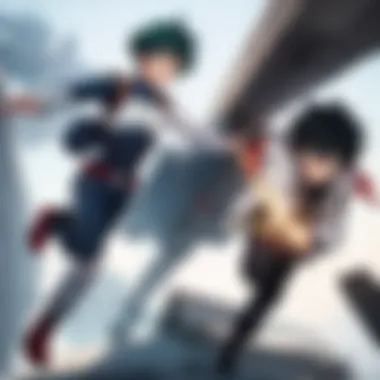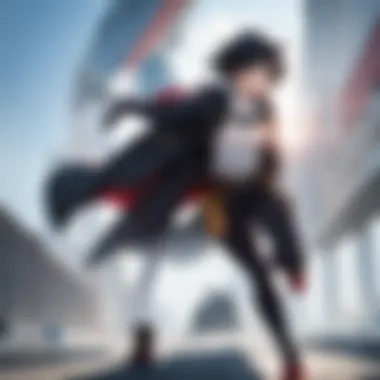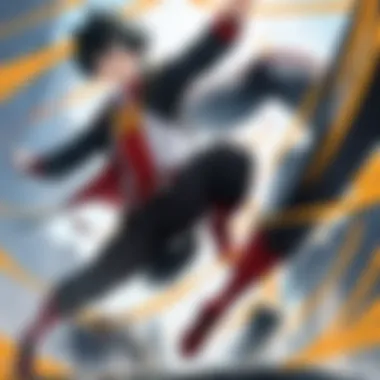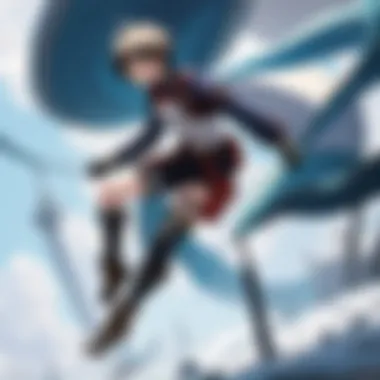Exploring My Hero Academia: A Deep Dive into Its World


Intro
In the realm of anime and manga, few series have captured the imaginations of audiences as profoundly as My Hero Academia. Created by Kohei Horikoshi, this series intertwines thrilling action with nuanced storytelling. At its core, it explores the inherent complexities of heroism, identity, and societal expectations all within a vibrant world brimming with unique characters and powers.
The purpose of this article is to dissect the multifaceted elements that make My Hero Academia not just a popular anime but a cultural phenomenon. By evaluating its themes, character arcs, and the broader implications within and outside Japan, readers will be positioned to appreciate the series in a deeper, more meaningful way.
Character Profiles
Understanding the characters is crucial to unlocking the layers of storytelling in My Hero Academia. Each character serves a purpose that propels the narrative and reflects the series' themes.
Overview of Main Characters
Izuku Midoriya: As the protagonist, Izuku—or Deku, as he’s affectionately known—starts his journey as a Quirkless boy in a society where superpowers dominate. His evolution from an underdog to a growing symbol of hope is meticulously illustrated through various conflicts and interactions.
All Might: The former number one hero, All Might is not only a mentor to Izuku but symbolizes the traditional values of heroism. His persona and legacy significantly influence the series' development and themes about the burden of heroism.
Shoto Todoroki: With his complex background, Shoto’s character tackles issues surrounding family expectations and personal identity. His struggle to reconcile his powerful abilities, derived from his parents, highlights the internal battles characters face in pursuit of self-acceptance.
Supporting Characters
Supporting characters bring depth and contrast to the narrative. Figures like Bakugo Katsuki, Ochaco Uraraka, and All Might’s supporters enrich the storyline with varied perspectives and conflicts that enhance character growth.
- Katsuki Bakugo: His rivalry with Izuku is both competitive and deeply personal, examining themes of friendship and conflict.
- Ochaco Uraraka: She embodies the gentle spirit of hope, providing balance to the more intense conflicts in the series.
Each character, whether main or supporting, serves to enrich the narrative, showcasing different facets of what it means to be a hero in an imperfect world.
Theme Exploration
Central Themes
My Hero Academia is rich with themes that resonate deeply in today’s society. Predominant themes include:
- Heroism and Identity: The show explores the moral complexities surrounding what it means to be a hero.
- Social Stratification: The series addresses societal expectations based on abilities, questioning inherent prejudices.
- Perseverance and Growth: Each character's journey emphasizes resilience, showing that growth is often fraught with challenges.
Cultural References
The narrative also reflects various cultural references, drawing parallels to Japanese societal values. Concepts such as honor, sacrifice, and community ties are woven throughout the story, grounding the fantastic elements in a recognizably human experience.
"In My Hero Academia, heroism is not just about powers; it embodies the struggles that define us as people."
Epilogue
My Hero Academia is more than just an adventure story; it is a complex narrative that invites viewers to reflect on their own understanding of heroism, identity, and community. Its cultural impact stretches beyond the screen, influencing a generation of anime and manga enthusiasts worldwide. As outlined, the series is a rich tapestry of characters and themes that ultimately compel audiences to consider what it truly means to be heroic in an imperfect world.
Prelims to My Hero Academia
The introduction of My Hero Academia serves as a foundational element of this article, providing context and insight into a series that has captured global attention. My Hero Academia, originally started as a manga by Kohei Horikoshi, has evolved into a prominent anime phenomenon. This section will highlight critical aspects of the series, illustrating its narratives, thematic explorations, and character complexities. By understanding the foundation on which the series is built, readers can appreciate more deeply the themes and characters that contribute to its lasting impact.
Overview of the Series
My Hero Academia follows the journey of Izuku Midoriya, a boy born without superpowers in a world where they are the norm. This setting creates an intriguing dynamic, as it explores what it means to be a hero. Midoriya's life changes when he meets All Might, the number one hero, who sees potential in him and passes on his quirk, a special ability, making Izuku's dream to become a hero a reality.
The series is rich in world-building, delving into the society shaped by these quirks. The narrative progresses through various arcs that introduce a diverse cast of characters, each with distinct personalities and motivations. The overarching theme of heroism permeates the storyline, examining the moral implications of power and the responsibilities associated with it.


Some key points to consider in My Hero Academia are:
- The exploration of heroism, particularly through the protagonist's growth.
- The different classes within society and the impact of status and power.
- Relationships among characters that form the emotional core of the series.
Significance in the Anime Landscape
My Hero Academia holds a significant place within the broader anime landscape. Since its debut, the series has established itself as a benchmark for modern shonen anime. It fuses traditional elements of the genre with contemporary themes. This combination resonates not just in Japan but across the globe.
The show has been praised for its character development and engaging story arcs, setting it apart from its contemporaries. Viewers appreciate how deeply the characters are explored, giving fans a chance to connect on an emotional level. Furthermore, My Hero Academia addresses social issues subtly woven into the narrative, such as discrimination and the quest for personal identity.
"My Hero Academia reinvents classic hero tropes, making them relevant to today’s audience."
The series has influenced many spinoffs and adaptations in the anime community. It's also helped to boost international interest in anime as a cultural product, paving the way for other series to gain traction. Its success illustrates the potential for anime to engage with complex themes while entertaining a broad audience.
Thematic Elements
The thematic elements in My Hero Academia are essential for understanding its depth. They enrich the narrative and reveal the complexities of characters and their motivations. This groundwork allows for a meaningful exploration of heroism, social dynamics, and interpersonal relationships. Each theme contributes to the overall impact and reception of the series, resonating with viewers on multiple levels.
Heroism and Identity
Heroism is at the core of My Hero Academia. The series presents a nuanced examination of what it means to be a hero. Izuku Midoriya, the protagonist, embodies the journey of self-discovery and moral growth. His transformation from an ordinary boy to a hero illustrates the challenges faced when pursuing one's identity in a world filled with expectations
The struggle between the idea of inherited power and personal effort becomes evident. Characters like All Might serve as symbolic figures of heroism. They embody ideals that many aspire to, yet their sacrifices and burdens reveal the darker sides of being a hero. Additionally, the exploration of identity is not limited to protagonists. Villains like Tomura Shigaraki reflect how trauma can shape one's identity, guiding viewers to reflect on the complexities within each character.
Social Class and Power Dynamics
Social class plays a significant role in My Hero Academia, influencing character interactions and plot development. The world is segmented into heroes, villains, and civilians, creating a clear hierarchy. This dynamic raises questions about privilege and the role of power in shaping societal structures.
Upper-class heroes often receive accolades and recognition, while lower-class individuals struggle for acceptance. This contrast highlights the disparities within society. The series also questions the morality of power, showcasing how the possession of Quirks can create rifts between classes. The hidden tensions provide a critical lens through which viewers can analyze real-world issues.
Friendship and Rivalry
Friendship and rivalry are crucial to the character arcs in My Hero Academia. Relationships among students at U.A. High School illustrate the balance between competition and support. Izuku's friendship with Katsuki Bakugo exemplifies this dynamic. Their rivalry pushes them both to grow while also addressing underlying insecurities.
The theme of camaraderie is not limited to heroes. Even villains share bonds that humanize them. This interplay between friendship and rivalry enhances character development and adds depth to their motivations. In a world where power can divide, the importance of genuine connections resonates strongly throughout the series.
Character Analysis
The exploration of characters within My Hero Academia serves as a cornerstone of its narrative engagement. Character Analysis is not only essential for understanding the intricate dynamics of power and identity but also reveals the thematic layers interwoven throughout the series. By delving deep into the characters, viewers not only appreciate their growth but also connect on an emotional level. Each character exemplifies different aspects of heroism, morality, and society's complexities. This insight not only enriches the viewing experience but also encourages discussions about personal values and societal roles, making it significant in today’s culture.
Izuku Midoriya: The Reluctant Hero
Izuku Midoriya, often referred to as Deku, represents the archetype of the reluctant hero. Born without a Quirk in a world dominated by superpowers, his journey encapsulates ideas of perseverance, self-discovery, and courage. His initial struggle highlights the notion that true heroism is not confined to strength but is tied to one’s moral compass and determination. As he trains under All Might, the Symbol of Peace, he undergoes significant transformation. His growth from a timid boy into a formidable hero resonates with viewers, making his character arc profound.
Midoriya's journey also touches upon the theme of mentorship, showcasing the impact that positive role models can have on one’s path. His relationships with peers, particularly with Bakugo, reflect the tension between rivalry and friendship, essential for personal development.
All Might: The Symbol of Peace
All Might embodies the ideals of heroism, serving as a beacon of hope and justice. As the former Number One hero, his presence in the series underscores what it means to protect society. His larger-than-life persona masks a deeper vulnerability that emerges in later arcs, effectively portraying the duality of strength and weakness. While he represents physical power, his lessons to Midoriya emphasize moral integrity and sacrifice.
All Might’s selflessness and commitment to peace inspire others and serve as a standard for aspiring heroes. His legacy is pivotal within the narrative, influencing the next generation and reinforcing the idea that heroism is a collective endeavor. His character imparts wisdom on maintaining hope amid chaos, making him memorable beyond his combat abilities.
Villains: Complex Antagonists


The villains in My Hero Academia are not mere obstacles for the protagonists; they are richly developed characters with unique motivations. Characters like Tomura Shigaraki and Stain serve to challenge the traditional hero narrative. Their backstories reveal personal struggles and traumas, enriching their antagonism. Shigaraki, in particular, highlights themes of disillusionment with society and the quest for identity.
"Villains represent the dark reflection of societal issues, often raising questions about morality and justice."
The inclusion of complex antagonists invites viewers to ponder the fine line between heroism and villainy. Unlike ordinary adversaries, these villains compel the audience to empathize with their motives, prompting discussions around moral ambiguity. Their presence adds depth to the plot and reinforces the series’ commentary on the nature of good and evil.
Supporting Cast: Roles and Development
The supporting cast in My Hero Academia plays a crucial role in enriching the narrative. Characters like Ochaco Uraraka and Shoto Todoroki, while not the central focus, contribute essential perspectives that illuminate various themes. Each character is crafted with distinct personalities and struggles, making them integral to the overarching story.
Uraraka brings a perspective on social class and the desire for personal agency, while Todoroki reflects the complexities of familial expectations and self-acceptance. The development of the supporting characters showcases diverse interpretations of heroism, contrasting Midoriya’s journey with their own experiences. This variety enhances the narrative tapestry, allowing for a more profound exploration of themes such as friendship, rivalry, and personal growth.
Narrative Structure
The narrative structure of My Hero Academia plays a crucial role in shaping the overall experience of the series. This aspect is not merely about the sequence of events; it delves deeper into how the story unfolds and how it impacts character development, thematic messaging, and audience engagement. A well-crafted narrative structure keeps viewers invested, making each episode a compelling piece of the larger puzzle.
Story Arcs and Their Implications
Story arcs in My Hero Academia are meticulously woven, allowing for significant character evolution and exploring complex themes. Each arc typically introduces new challenges that characters must face, dealing not only with external conflicts but also their internal struggles and growth. For instance, the Training Arc emphasizes personal development, showcasing how characters confront their limitations. This is not just for entertainment; it highlights the universal struggle of self-improvement and the pursuit of excellence.
Additionally, different arcs represent broader societal issues such as class disparities and what it means to be a hero in a morally complex world. The implications of these arcs resonate with viewers, inviting them to reflect on their values and beliefs.
Foreshadowing and the Plot's Evolution
Foreshadowing is a powerful tool used throughout the narrative of My Hero Academia. It creates a rich tapestry that enhances plot evolution. By hinting at events or character decisions before they take place, the series builds anticipation and tension. For example, subtle hints regarding a character's lineage or potential abilities may appear long before they become significant. This technique allows audiences to engage more actively with the story, as they begin to connect the dots of the unfolding plot.
Moreover, foreshadowing often contributes to a sense of continuity and depth within the universe. Each revelation not only develops the immediate storyline but also enriches the larger narrative context, reinforcing the interconnectedness of various characters and their journeys.
Art and Animation Style
The art and animation in My Hero Academia play a critical role in shaping the viewer's experience. The visual elements not only enhance storytelling but also deepen the connection between characters and the audience. This section will detail important facets of character design and action sequences, showcasing how these elements contribute to the overall impact of the series.
Character Design: Individual and Collective
Character design in My Hero Academia is both distinctive and functional. Each hero and villain has a unique look that reflects their abilities, personality, and background. For example, Izuku Midoriya wears a costume that symbolizes his growth, combining his childhood aspirations and the responsibilities he must face as a hero.
The individual designs often draw from traditional superhero aesthetics while incorporating quirky elements that highlight Japan's manga culture. The array of characters, from the flamboyant personalities like Shoto Todoroki to the more reserved figures like Tenya Iida, offers a rich tapestry of styles.
Collectively, these designs contribute to the broader theme of heroism and identity. The stark contrasts in character appearances underline the diversity of perspectives within the series. The visuals resonate with viewers, providing immediate insights into the characters' motivations and roles in the story.
Action Sequences: Choreography and Execution
Action sequences are a hallmark of My Hero Academia. The choreography is meticulously crafted, blending fluid movements with dynamic camera angles. This not only amplifies the intensity of battles but also makes them visually captivating. Animators use techniques such as slow-motion and zoom shots to enhance the drama during key moments.
The execution of these sequences shows a deep understanding of motion and pacing. Each fight serves a dual purpose: to entertain and to progress the plot. For instance, the battles are not just about physical strength but often embody moral dilemmas and character development. This multi-layered approach makes the action more meaningful.
"The art style of a series is not merely decorative; it conveys character emotions, themes, and the very essence of the narrative."
Cultural Impact and Reception
Cultural impact and reception are integral to understanding any creative work, and My Hero Academia is no exception. The series has not only made a mark in Japan but has also transcended cultural boundaries, influencing global anime trends and shaping viewer expectations. Analyzing its cultural implications helps us appreciate the unique elements that resonate with audiences worldwide.
Influence on Global Anime Trends


My Hero Academia has contributed significantly to the evolution of anime as a medium. Its popularity has encouraged other creators to explore similar themes of heroism, personal growth, and societal responsibilities. Since its debut, the series has impacted the perception of shonen anime, demonstrating that there is a strong market for complex narratives and well-rounded characters. Moreover, the focus on both heroics and the associated struggles is a reflection of contemporary societal issues, appealing to a diverse audience.
The ripple effect of My Hero Academia can be seen in various aspects:
- Merchandising: The series has led to a surge in merchandise related to anime culture, including figures, clothing, and accessories, contributing to the commercial growth of anime globally.
- Storytelling Techniques: It has inspired other anime creators to adopt multi-dimensional storytelling approaches, where character arcs are interwoven with broader social narratives.
- Diversity in Characters: The inclusion of characters with different abilities and backgrounds promotes diversity, which resonates with audiences seeking representation in media.
This transformation in trends not only enhances the shonen genre but also creates a more inclusive environment for fans of all backgrounds.
Fan Reception: Community Perspectives
The reception by fans has significantly influenced My Hero Academia's trajectory. Community perspectives reveal how deeply the series resonates with viewers on an emotional level. The series initiates discussions around heroism, identity, and moral obligations, which leads to a passionate fan base active on platforms like Reddit. Fans analyze characters, theories, and socio-political themes, fostering a vibrant discussion community.
"My Hero Academia isn’t just an anime; it’s a narrative that challenges us to think about what it means to be a hero in our own lives."
This comment encapsulates the sentiments shared within fan circles. Key points of discussion often include:
- Character Loyalty: Fans appreciate character development, often forming attachments that drive discussions.
- Relevance of Themes: The series' exploration of societal issues resonates with fans, making them reflect on their own struggles.
- Creative Fandom: The vibrant community of creators produces art, blogs, and fan fiction that expands the universe of the series, providing additional layers to the original narrative.
The combined impact of global trends and community reception reinforces the significance of My Hero Academia as a cultural touchstone in contemporary anime. Understanding these dynamics fosters a deeper appreciation of the anime and its lasting impact.
Comparative Analysis
The comparative analysis of My Hero Academia serves as a pivotal segment in understanding its place within the anime and manga landscape. By examining this series alongside other shonen titles, we can identify defining features that contribute to its distinctiveness. This comparative lens not only highlights its unique narrative structures but also unveils shared themes and motifs prevalent in the genre.
Engaging in comparative analysis allows enthusiasts to grasp the broader implications of My Hero Academia and how it resonates with audiences compared to its contemporaries. It invites rich discussions concerning character development, thematic depth, and audience engagement strategies. The insights gained from this analysis are invaluable for both fans and creators, encouraging a deeper appreciation of the craft involved in anime storytelling.
My Hero Academia vs. Other Shonen Series
My Hero Academia establishes itself uniquely in the shonen category, often compared to titles like Naruto and One Piece.
- Theme of Heroism: While many shonen series embrace the concept of heroism, My Hero Academia distinctly revolves around the societal implications of being a hero. Izuku Midoriya's journey reflects the struggle within a system that idolizes heroes, highlighting the complexities of their roles.
- Character Dynamics: The interplay of characters like All Might and Deku offers a mentor-student dynamic that is less prominent in other series. The relationships are built on a foundation of growth, vulnerability, and responsibility.
- Societal Setting: Unlike typical settings centered around fantasy worlds, My Hero Academia reflects a contemporary society where quirks—and the societal norms that evolve from them—create unique conflicts and moral dilemmas.
These distinctions carve out a niche that resonates with both younger audiences and older viewers, establishing a broader cultural impact.
Narrative Techniques Compared
The narrative techniques in My Hero Academia present an opportunity to assess how storytelling strategies influence viewer engagement. Compared to typical shonen techniques, this series employs several distinct methodologies.
- Non-linear Storytelling: My Hero Academia often revisits past events to provide context to character motivations. This technique fosters a deeper connection with the audience as they witness character evolution alongside plot progression.
- Balancing Humor and Drama: The series adeptly intertwines humor with intense emotional moments. Unlike some shonen series that lean heavily on one, My Hero Academia maintains a balance that keeps viewers invested without diminishing seriousness.
- Diverse Perspectives: Employing multiple points of view allows for a richer narrative fabric. Characters’ backstories are woven throughout the main plot, enriching the story and offering different interpretations of heroism and morality.
The effectiveness of these narrative techniques enhances both character immediacy and emotional stakes, navigating beyond traditional shonen tropes.
By comparing narrative styles and thematic approaches, fans gain insight into the structural elements that make My Hero Academia a compelling and resonant experience in the shonen genre.
The End
The conclusion of this article encapsulates the significance of My Hero Academia within the broader context of anime and narrative storytelling. This series has become a focal point for discussions about the nuances of heroism, identity, and societal challenges. As the narrative progresses, the series not only entertains but also provokes thought about moral dilemmas and personal growth. It serves as a mirror to reality, reflecting both the potential for greatness and the pitfalls of one’s limitations.
The Future of My Hero Academia
Looking ahead, My Hero Academia appears to be on a promising trajectory. With continuous character development and evolving story arcs, the potential for fresh narratives is vast. Fans can expect deeper explorations of character backstories and new conflict resolutions. This anticipation keeps the community engaged and excited for what lies in store.
Moreover, with the increasing popularity of the series, there is ample opportunity for various adaptations. This could include new video games, spin-off series, or even movies. As the anime industry grows globally, My Hero Academia could leverage its extensive universe for expansion creatively.
Final Thoughts on its Legacy
Ultimately, the legacy of My Hero Academia will be defined by its influence on future generations of creators and fans alike. It has already reshaped conventional perceptions of heroism within anime. This series challenges the notion of a stereotypical hero and instead embraces complexity in character portrayals.
"The series provides a fresh take on what it means to be a hero, making it a critical part of contemporary anime discussions."
Readers can explore more about the series' themes and impact through resources like Wikipedia or join discussions on platforms such as Reddit.
Stay engaged, as the world of My Hero Academia continues to unfold.







